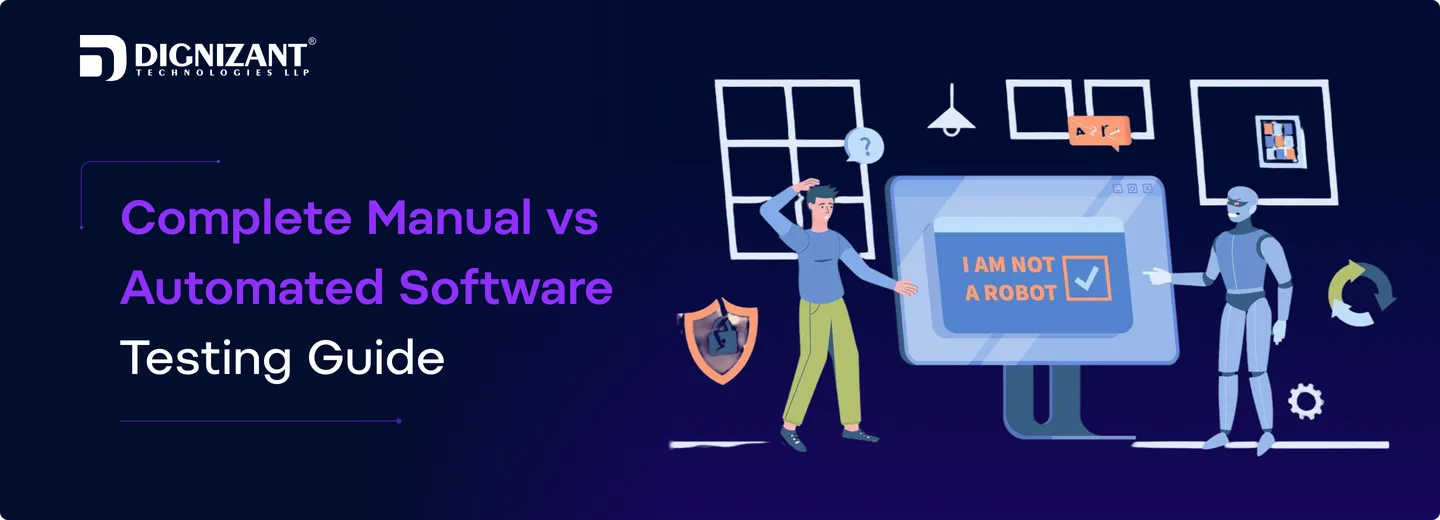Complete Manual vs Automated Software Testing Guide

Contributor
Vipul Kantharia
Uploaded
13 November, 2025
Read Time
6 Minutes
Modern software is the backbone of nearly every industry, and we live in the software powered world. Web based system or e-enterprise application, mobile application making software work well is critical. Testing is what allows this to happen.
With development cycles becoming shorter and users expecting more, teams are asking themselves a fundamental question, should they base their testing around human testers or automation? The answer lies in the strengths of both.
This all embracing tutorial investigates each element in Manual and Automated Software Testing that, to the best extent possible, will enable the reader to decide when to use one or the other, the benefits of each approach and how to blend them in such a manner that delivers speed, accuracy and quality at the same time.
What Is Software Testing and Why It Matters
Software testing is the act of verifying the application is working as expected, is safe and runs in an efficient manner before it goes in the hands of the user. It enables early detection of bugs, performance bottlenecks, and usability issues, which significantly reduces the cost of fixing them in later stages.
Testing is not just for exposing defects, but it is for building confidence. Companies that invest in testing reap the rewards of smoother releases, higher levels of customer satisfaction, and more robust brand reputations. In short, testing makes a working product into a reliable product.
Understanding Manual Testing
Manual Testing is a converse, indispensable element of software quality assurance. Here a human tester runs the test cases step by step without using any automation tools. They watch the application, take notes, and file bugs in a coordinated manner.
It’s the best for projects that require artistic judgment, for example, evaluating user experience or interface design. Human testers can also catch problems automation may miss, such as confusing layouts, bad navigation or surprising answers.
Manual testing is ideal for:
- Exploratory testing of new features.
- Checking visual design and usability.
- Situations requiring human judgment or flexibility.
While it allows creativity and adaptability, manual testing can be time consuming for large projects or repetitive tasks.
Understanding Automated Testing
Automated Testing runs test scripts using special software tools. With automation, you don’t need to run each step manually, you can have multiple tests running at once, with results that are consistent and quick.
This is particularly useful for projects with iterative testing such as regression or load testing. After it is established, automation saves time, eliminates human error, and guarantees that the software acts the same way across different versions.
But automation is an expertise, it requires maintenance, and an up front investment in tools and setup. Despite these difficulties, it affords wonderful speed and accuracy in the right hands.
The Role of Manual and Automated Software Testing
Quality assurance is best left to Manual Software Testing and Automated Software Testing in unison. Manual testing brings human perspective, empathy and creativity, while automation brings accuracy, uniformity and the ability to scale.
An automation system can efficiently perform tedious tasks, but it is ultimately a human who evaluates how intuitive or enjoyable using a product is. The result is a comprehensive, well rounded testing environment that covers the functionality, performance and user satisfaction.
Contemporary methodologies are commonly a combination of both manual testing to validate the design, and automated testing to handle repetitive or high volume testing requirements.
When to Use Manual Testing
Manual testing is most suitable when human intelligence and flexibility are needed. You should pick it when:
- The application is in its early development stage.
- You are working with visual elements, usability or accessibility.
- Exploratory or ad hoc testing is required for quick validation.
Manual testing allows for a human point of view in testing which you cannot get with an automation script.
When to Use Automated Testing
Automation is particularly effective when the tests have to be run repeatedly or in many different environments. It’s perfect for:
- Regressing and smoke testing.
- Big projects that are continuously tested.
- Under continuous integration and delivery pipelines projects.
Automation increases productivity, decreases testing time and ensures uniform quality in multiple release cycles.
Benefits of Manual and Automated Software Testing
1. Improved Efficiency
Automation is used for repetitive tasks while the manual testers spend more time on the creative or complicated scenarios. They work together to increase the speed of testing and the coverage.
2. Cost and Time Optimization
Manual testing is economical for smaller projects, while automation minimizes the long term costs by running the tests often, without any additional work.
3. Comprehensive Quality Coverage
When you use automation, you get technical accuracy and when manual testing, you get real world usability. When you put the two together, you have a 360° perspective on software quality.
4. Better Accuracy and Reliability
Manual testing brushes subtle design and experiential issues whereas automation provides technical soundness and data validation.
5. Scalability and Consistency
Together Manual and Automated Software Testing solutions enable organizations to efficiently scale their QA processes to ensure quality is maintained across multiple releases and platforms.
The Role of Test Automation in Modern QA
Test Automation is now an essential part of today's agile and devops pipelines. Automated tests are executed repeatedly throughout development to catch problems before they ever reach production.
Speedy releases and sustained quality are made possible by automation. It's a great way to test each build the same way, every time, and provide developers with immediate feedback. But automation doesn’t replace human testers, it enables them by taking away the tedium so they can concentrate on strategic, exploratory, and inventive testing.
Challenges in Manual and Automated Software Testing
There are challenges associated with both approaches that businesses need to be prepared for:
- Manual testing is laborious and skill dependent.
- Automation also involves technical expertise, initial investment, and maintenance cost.
- Rapid UI changes may cause automated scripts to fail, unless maintained frequently.
- They both need to be well planned and documented then communicated clearly to get accurate results.
Although there are some challenges, the advantages of a hybrid approach far exceed the disadvantages, if carried out with strategic foresight.
Choosing the Right Testing Approach
The choice between manual and automated tools is a matter of project objectives, deadlines, and scope. Most companies function best with a hybrid model.
Use manual testing when creativity and user experience are paramount. Automate wherever possible for repetitive, data heavy, or large scale testing. What they add up to is a comprehensive test process that makes for rapid delivery and exceptional quality.
Consider issues such as the complexity of the project, the expertise of the team, and long term maintenance needs before making a choice. It's not about picking one over the other but crafting a vernacular for both.
Future of Software Testing
Robotic Process Automation has the potential to bring major disruptive changes in the field of software testing in future. Intelligent systems will anticipate defects, produce test cases automatically, and evolve in pace with application modifications.
Still, human testers will remain crucial for creative problem solving, critical thinking and evaluation of the user experience. The future is for the teams that combine the efficiency of automation and the intelligence and empathy of humans.
Conclusion
In the changing era of software development testing, success is determined by testing. Human expertise and machine accuracy gives a perfect digital product.
Manual and Automated Software Testing are not foes, they are allies. A human element is required for user satisfaction which can be provided by manual testing and speed, accuracy, and scalability can be achieved through automation.
Combining the best of both worlds and making best use of Test Automation, organisations can produce trusted, high quality software that meets today’s challenges. The ideal testing approach isn’t to substitute people with machines, but to enable both to excel together.
Latest Articles

Unsure if Python suits your project? Explore the advantages and disadvantages of Python to see if it’s the right choice for your needs.

A practical guide to web performance optimization strategies that enhance speed, stability, and user satisfaction in real-world scenarios.

Deploy modern apps faster with top serverless frameworks. Compare features, DX, scaling, cost controls, and CI/CD fit for production-ready releases.
FAQs
Ready to Take Your Business to the Next Level?
Unlock new opportunities with expert solutions designed to elevate your brand. From strategy to execution, we empower your business with the tools, technology and talent it needs to thrive in today’s digital world.




